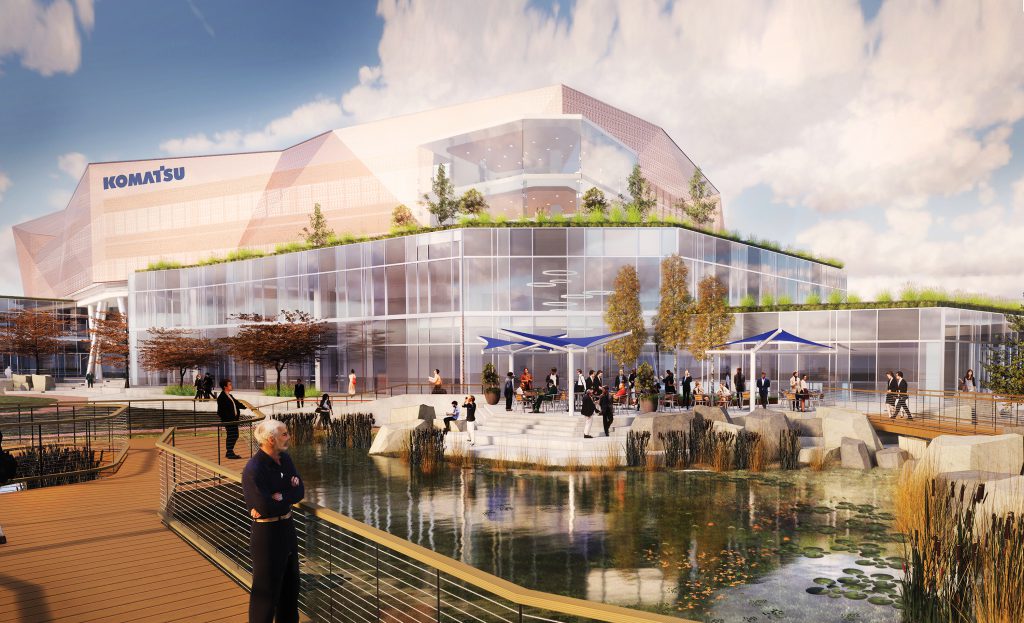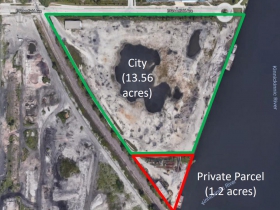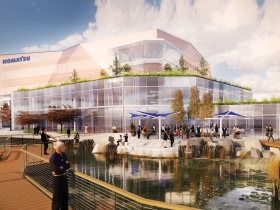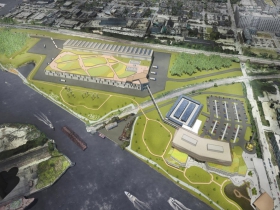Committee Okays $40 Million For Komatsu
But financing for $285 million manufacturing campus gets blasted by Ald. Bauman.
“Eleven jobs per acre on the waterfront? I think that’s pathetic.”
Alderman Robert Bauman isn’t pleased with the Department of City Development‘s plan for 68 acres of waterfront land in Milwaukee’s Harbor District. DCD is proposing to sell a 13-acre parcel to industrial giant Komatsu for a new headquarters and manufacturing campus for its Komatsu Mining division, the result of purchasing the old Joy Global company. The city land would be combined with a 46-acre brownfield site owned by We Energies to form the site for a $285 million campus. Komatsu Mining intends to relocate from suburban West Milwaukee to the waterfront site in 2022.
The company would bring its 598 West Milwaukee full-time employees with it, and after excluding land to be used for public infrastructure, including a 4,300-foot riverwalk segment, would be creating 11 jobs per acre. By 2031, the company projects to be employing 946 people at the campus, with the potential to grow to 1,300 in 25 years. If that growth is realized, the company would have over 22 jobs per acre, the number used by DCD Commissioner Rocky Marcoux in describing the deal. The company would be eligible to earn a total of $18.2 million plus interest over 25 years if it employs 946 people and up to $25 million if it can reach the 1,300 figure.
“In the year 2035, we will get to 22 jobs per acre, maybe, and we’re giving up what I think is extremely desirable real estate in the city of Milwaukee,” said Bauman. Later in the meeting, he contrasted the deal with the nearby Michels Corp. project that would create a minimum of 41 jobs per acre, and potentially over 100. “This is how riverfront land should be developed,” said Bauman of the Michels deal.
Marcoux, and Michels, are supportive of both deals. “I think this is a very good investment strategy for the City of Milwaukee,” said Marcoux. “They’re creating the value, and we’re benefitting from the value equally with the company.” Komatsu, after first building a new office building, factory and training center, would receive the city subsidy only as the incremental property taxes on the development allow. The proposal, known as a developer-financed tax incremental financing district, effectively rebates property tax payments to developers in exchange for capital investments. The city has used the tool on a number of new projects, including the Northwestern Mutual Tower and Commons. “We have what we believe will be one of the best urban success stories in the United States,” said Marcoux.
Marcoux, who in a hearing before the City Plan Commission characterized the deal has the most difficult one he has worked on, praised Komatsu’s commitment and vision. “Most companies that are expanding choose the easy route. They go into suburbs and plow up a cornfield.”
But Komatsu’s decision to instead move a few miles east has Bauman scratching his head: “My fundamental question is… what’s wrong with West Milwaukee?”
John Koetz, surface mining president for Komatsu, responded: “First, let me say there is nothing wrong with West Milwaukee.” He characterized the village as a great partner when it comes to looking at redevelopment options. “The challenge with our current facility is that it’s 115 years old and it was designed for a different product mix.” Koetz, who noted the W. National Ave. site is actually larger than the proposed South Harbor Campus, said that retooling the West Milwaukee site to the company’s needs would involve effectively shuttering the facility for three years.
When pushed by Bauman on what would happen if the Common Council didn’t approve the financing deal, Koetz said the company would reconsider other sites it previously considered, including 2,000 acres the company owns in Texas and a site in Peoria, Illinois where the company makes other equipment. “This is still the strongest manufacturing environment in North America,” said Koetz about why the company wants to stay.
Beyond the job density, Bauman isn’t pleased with the design or lack thereof for the facility, and the control the city will have over it. Komatsu has to date only produced conceptual renderings and will hire a project architect in the future. The proposal would meet existing zoning for the site, which largely ties the city’s hands according to Marcoux. “Rocky, we own the real estate, the zoning is irrelevant, we can attach any condition we want to this deal,” offered Bauman. “It looks like something I would see in Brookfield or Pewaukee along the freeway,” he said of the available renderings which depict a large surface parking lot and 550-stall garage along E. Greenfield Ave. “I just want everybody to know that we’re giving up any design control on what this ultimately looks like.”
When asked by area alderman Jose G. Perez if DCD would work with his office and the non-profit Harbor District Inc. on the buildings’ design, Marcoux was able to mollify Perez and other committee members by saying yes. “That is my commitment to you,” said the commissioner. Perez was repeatedly credited throughout the hearing for pushing to include the riverwalk component. Alderwoman Milele A. Coggs also raised safety concerns with the design of the riverwalk, something that Marcoux promised to address.
The deal is supported by Port Milwaukee director Adam Schlicht. The port, a city-owned entity, would receive the approximately $1 million in proceeds from the land sale in exchange for foregoing future revenue on the land, but in turn hopes to use the riverwalk land retained by the city to dock cruise ships. In response to a question from Coggs, Schlicht said the cruise ships would certainly be a revenue generator for the port. One ship docked in Milwaukee this year in the middle of a journey, but the port’s vision is to become a destination for the more lucrative start or end of trips.
After almost two hours of debate, the committee was ready to vote on the proposal, and that left Bauman on an island. The land sale and TIF district were approved on 4-1 votes with only Bauman in opposition.
Council president Ashanti Hamilton made a rare appearance before the committee to endorse the project and support the debate. “This is what the committee process should look like. People are supposed to ask questions and dig into the project,” said the possible mayoral candidate.
The deal will now go before the full Common Council for approval. After environmental remediation is complete, the company hopes to be able to break ground by the end of 2019. The state would also contribute $59 million in income tax credits as part of the proposal.
Komatsu Site Plans
If you think stories like this are important, become a member of Urban Milwaukee and help support real independent journalism. Plus you get some cool added benefits, all detailed here.
More about the Komatsu South Harbor Campus
- Construction Beginning On Milwaukee’s Largest-Ever Riverwalk Expansion - Jeramey Jannene - Jun 20th, 2025
- Eyes on Milwaukee: City Expands Vision For Harbor District Riverwalk - Jeramey Jannene - Sep 16th, 2022
- Eyes on Milwaukee: Inside Komatsu Mining’s Massive New Harbor District Campus - Jeramey Jannene - Jun 27th, 2022
- Eyes on Milwaukee: Planned Riverwalk Lets You Touch the Water - Jeramey Jannene - Nov 22nd, 2021
- Friday Photos: South Harbor Campus Rising Over Inner Harbor - Jeramey Jannene - Apr 30th, 2021
- Eyes on Milwaukee: SmithGroup Will Design Harbor District Riverwalk - Jeramey Jannene - Apr 30th, 2021
- Transportation: State To Fund Road, Rails for Komatsu - Jeramey Jannene - Mar 9th, 2021
- Eyes on Milwaukee: Who Wants To Design Harbor Riverwalk? - Jeramey Jannene - Mar 2nd, 2021
- Transportation: Railroad Expansion in the Harbor District - Jeramey Jannene - Feb 17th, 2021
- Friday Photos: Komatsu Mining Campus Takes Shape - Jeramey Jannene - Nov 6th, 2020
Read more about Komatsu South Harbor Campus here
Eyes on Milwaukee
-
Church, Cupid Partner On Affordable Housing
 Dec 4th, 2023 by Jeramey Jannene
Dec 4th, 2023 by Jeramey Jannene
-
Downtown Building Sells For Nearly Twice Its Assessed Value
 Nov 12th, 2023 by Jeramey Jannene
Nov 12th, 2023 by Jeramey Jannene
-
Immigration Office Moving To 310W Building
 Oct 25th, 2023 by Jeramey Jannene
Oct 25th, 2023 by Jeramey Jannene
























